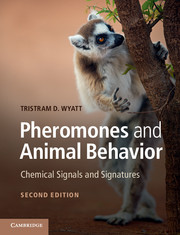Book contents
- Frontmatter
- Dedication
- Contents
- Preface to the second edition
- Acknowledgments
- List of SI prefixes
- List of Abbreviations
- 1 Animals in a chemical world
- 2 Methods for identifying and studying semiochemicals
- 3 Pheromones, chemical cues, and sexual selection
- 4 Coming together and keeping apart: aggregation pheromones and host-marking pheromones
- 5 Territorial behavior and semiochemicals
- 6 Semiochemicals and social organization
- 7 Pheromones and recruitment communication
- 8 Fight or flight: alarm pheromones and cues
- 9 Perception and response to chemical communication: from chemosensory receptors to brains, behavior, and development
- 10 Finding the source: pheromones and orientation behavior
- 11 Breaking the code: illicit signalers and receivers of semiochemicals
- 12 Using semiochemicals: applications of pheromones
- 13 On the scent of human attraction: human pheromones?
- Appendix An introduction to chemical terms for non-chemists
- References
- List of Credits
- Index
12 - Using semiochemicals: applications of pheromones
Published online by Cambridge University Press: 05 June 2014
- Frontmatter
- Dedication
- Contents
- Preface to the second edition
- Acknowledgments
- List of SI prefixes
- List of Abbreviations
- 1 Animals in a chemical world
- 2 Methods for identifying and studying semiochemicals
- 3 Pheromones, chemical cues, and sexual selection
- 4 Coming together and keeping apart: aggregation pheromones and host-marking pheromones
- 5 Territorial behavior and semiochemicals
- 6 Semiochemicals and social organization
- 7 Pheromones and recruitment communication
- 8 Fight or flight: alarm pheromones and cues
- 9 Perception and response to chemical communication: from chemosensory receptors to brains, behavior, and development
- 10 Finding the source: pheromones and orientation behavior
- 11 Breaking the code: illicit signalers and receivers of semiochemicals
- 12 Using semiochemicals: applications of pheromones
- 13 On the scent of human attraction: human pheromones?
- Appendix An introduction to chemical terms for non-chemists
- References
- List of Credits
- Index
Summary
The importance of smell in the natural behavior of animals has long been recognized and, long before it was known what semiochemicals were, people used them to manipulate the behavior of animals. For example, traditionally farmers have encouraged a mother sheep (ewe) to adopt a strange lamb if her own died at birth, by covering the strange lamb with the skin of her dead lamb (see Chapter 9).
The clear potential for applied uses of pheromones was an early encouragement for research. At the turn of the twentieth century and in its first few decades, the potential of synthetic chemical signals to control insect pests was anticipated both in North America and in Europe (Witzgall et al. 2010). There is now increasing use of an understanding of semiochemicals to affect the behavior of domesticated animals, from bees to sheep, as well as use as “greener” alternatives to pesticides, largely for the control of insect pests but also potentially for vertebrate pests. However, no matter how elegant the science, pheromones will be exploited only if they are commercially viable, though that can be strongly influenced by government policy (Chandler et al. 2011; Winston 1997). Human odors will be discussed in the next chapter (Chapter 13).
- Type
- Chapter
- Information
- Pheromones and Animal BehaviorChemical Signals and Signatures, pp. 260 - 274Publisher: Cambridge University PressPrint publication year: 2014



